Visit to the Neighbour Islands of Venice
A view and/or a visit - expanding one's horizons

The city of Venice consists on six districts, the so-called sestieri (translated six parts): San Marco, Santa Croce, San Polo, Castello, Cannaregio and Dorsoduro. The six city districts form the core of the oldtown that can be comfortably walked in one day. But Venezia offers much more than the core of the oldtown, as the city is located amidst a great natural landscape, a sea lagoon named the Laguna Véneta, located in the northern Adria with countless small islands around.
As soon as during one's city walks one gets for the first time to the shore, no matter if it is by San Marco at the Riva Degli Schiavoni or even at the north at the Fondamenta Nuove, the closely located neighbour islands cath one's attention and the wish comes up to leave the mainland - if this word can be used at all in case of the city Venice - and to continue the exploration in one of the neighboured islands.
The number of the islnds in the lagoon of Venice is almost uncountable if one includes each tiny island into the list. Some islands consist in reality of a bigger number of single islands that are communicated by big or smaller bridges. But many islands have one thing in common: they have a very certain significance and function, by which they differentiate from all other islands.
Thus, for example in Murano, the glassblowers settled, in Burano to the contrary, the lacemakers. The island San Michele with its fortification-like encircling wall is nothing more than the cementery island of Venice. On the island Sant'Erasmo vegetables are cultivated, in Torcello, the bishop once resided. Moreover, the long extended sand island Lido is of course to mention, that protects the sea lagoon against big waves .
The Island of Glassblowers Murano
The small island Murano is probably the most famous neighboured island of Venice. those who can somehow arrange it with their time should get to Murano with the vaporetto and explore the island. Depending on each one's interest, it takes approximately 2-4 hours to view the island of the glassblowers. Murano is indeed a small and clearly arranged island with barely 7000 inhabitants, but it has several vaporetto-stations. I recommend to get out straight in the firt station and start from there a city walk.
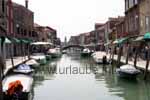
In principle, it doesn't really matter in which direction one starts having the walk; one can go wherever one wants to on this small island, one always comes across again to the main road and/or the main channel Rio Di Vetrai. The main road reminds on the pedestrian area of a German small city: here, the life takes place, here are the shops and the restaurants, here, the ships and boats navigate and park. On this main road, it is possible to promenade unhurriedly and enter into one glass shop after the next one.
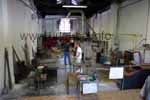
And therewith, we already talk about the main topic and/or the actual reason for a visit to the island Murano. On the island that is inhabitated since approximately 1400 years, the glassblowers settled down, and still today, the name Murano has a world wide excellent reputation in the glass manufacturing sector. There are numerous shops where one can buy and look at come vases, pendants, sculptures and other gimmicks made from Murano-glass.
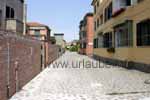
But what would be a glassblower-island without being able to watch some real glassblowers during their work? The glass manufactures allow watching the production of simple glass items. Of course, the entrance is free of charge, finally, they want to sell the visitirs something from the own factory. Those who have never seen how a drinking glass or a flower vase is produced, should in any case have a look. It is a fascinating to see liquid and red-hot glass.
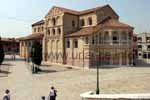
Those who want to know more about the production of glass and specially about the history of the glassblowing I recommend to visit the museum Museo Del Vetro in Murano. In this museum, thw 1000-year-old history of the glassblowing is represented and documented by thousands of objects like vases, mirrors, drinking vessels, pearls or pendants.
Murano is, by the way, something like small-Venice. The system of water streets and bridges is the same. But what is completely different is the life on the island. This is notable by walking aimlessly through the oldtown of Venice through the alleayways of the island. While in Venice one is continuously hit and channeled by straying tourists, in Murano, one finds some lonely small streets where the neighbours greet each other from window to window. A nice contrast to the totally overflowed oldtown of Venezia!
The Cementery Island San Michele
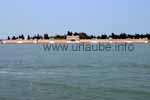
If one walks in the city district of Venice Castello to the northern boardwalk, the Fondamenta Nuove, one has a straight view to an island that is surrounded by a big wall as it was a maximum security prison. Due to the high trees behuind the wall one could also think that the whole island is a private property and that behind the walls, there is a majestic villa or even a castle in a huge palace garden.
But it is not like this at all. The Isola Di San Michele is nothing else than a cementery island of Venice. Here, there are also either some single small tombs as we know them but also big sepulchers at which one can only gaze at. A visit to the cementery island is not worthwhile, one rather passes it during a boat trip to Murano. But it is interesting to know that behind this mighty island protection wall there is nothing else but the cementery of Venice's last resting place for its deceased.
Isola Di San Giórgio Maggiore
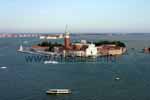
The probably most photographed island of the lagoon is the Isola Di San Giorgio Maggiore; in this island, one has a wonderful view from the Campanile tower at the Piazza San Marco. The picturesque small island wit the pompous convent and the second Campanile in the centre of the island is simply a perfect photo motif for each "climber" of the Campanile. But the samll island Giorgio Maggiore should not only be pictured but also visited!
In a few minutes one is transferred by the vaporetto to the small neighbour island an is able to look closely at what was slowly approaching one during the boat trip. The convent complex of the 16th century waits with a shining white marble wall covering and invites the visitor to the three-naved church.
Those who do not want to take a boat trip just to see one more church - finally, one probably has already visited countless churches in the oldtown of Venice - will not regret having crossed the channel when ascending the Campanile of the island. The view from this clock tower to the oldtown of Venice and the sorroundings is at least as impressive as the view from the Campanile at the Piazza San Marco.
Burano and Torcello
Further to the north of the lagoon of Venezia there are the two islands Burano and Torcello. One does need a lot of time to include these two islands in one's schedule for Venice, as with the vaporetto it takes approximately a three quarter of an hour until one finds his feet again.
In the island Burano, the lacemakers settled down. By this way, each island has its emblem and/or its own product that made it famous. Burano is a nice small island with some funny coloured small houses, small channels and tiny bridges over them. Somehow,the island seems to be of a fairy tale. Those who want to learn more about the tongues laces (merletti in Italian), can do this in the Museo del Merletto of the island.
The once active and populous island Torcello is today a place of calmness and reflection. People come here to get some distance from the hustle and bustle, if they want to hace a calmed walk or if they want to afford themselves a gourmet-dinner. What is well worth seeing on the island that was in former times even a bishop's see, is a cathedral that is more than 1000 years old, die Santa Maria Assunta, with gorgeous mosaics to gaze at.
Isola Della Giudecca
The long-extended Isola Della Giudecca is located at the south of the oldtown of Venice and is divided by it through the wide channel Canale Della Giudecca. This island can also be easily accessed by a vaporetto. Actually, one should say that the Isola Della Giudecca is formed by eight small islands, but they are all communicated with each other.
The island waits with some well worth seeing churches, at the very east tip, the citadel, then at the west the Redentore and the S. Eufemia. The Redentore is a big domed structure of an impressive marble-wall covering. But what is much more interesting than the visit of the churches is a walk alongside the northern boardwalk. One continuously enjoys a nice view to the coat of the oldtown of Venice. This is the way having a walk is enjoyable!

Back to the index Venice
Copyright: Patrick Wagner, www.tourist-guide.biz
|